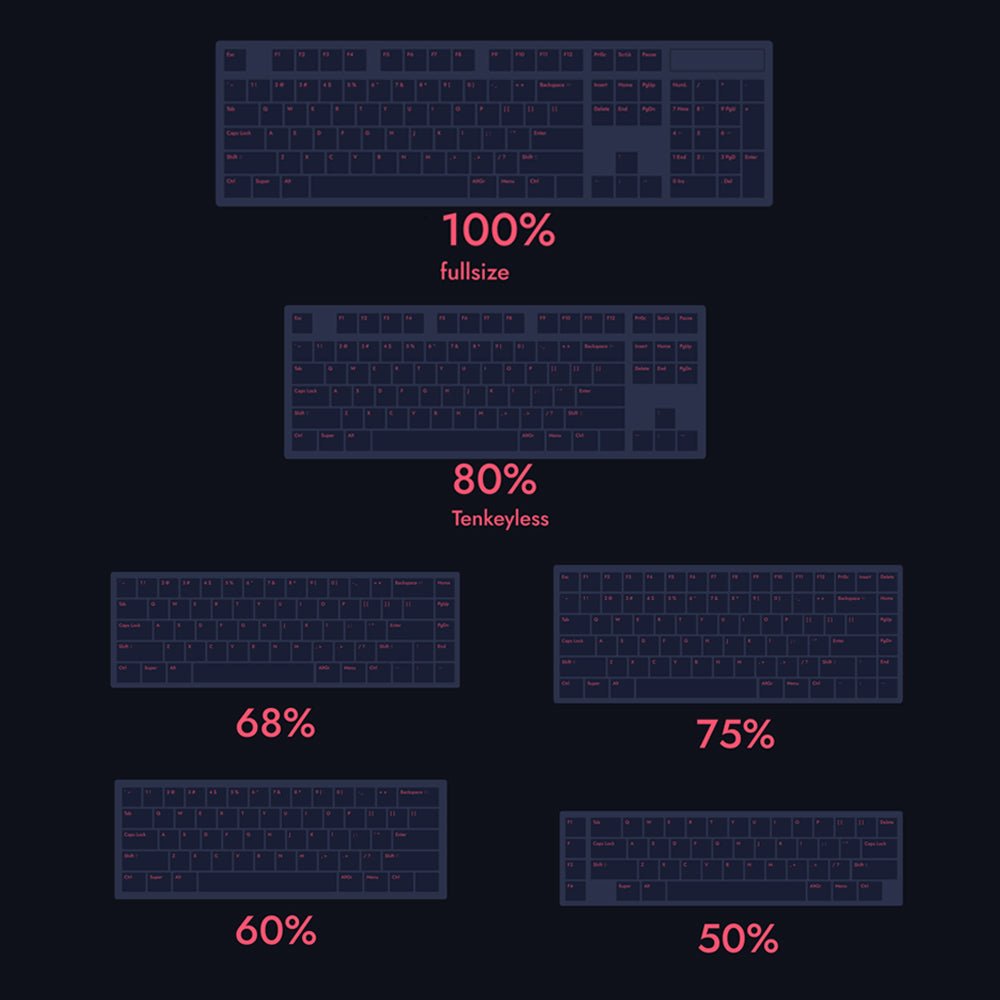The Ultimate Guide to Keyboard Sizes and Layouts: Everything You Need to Know

Picture from u/alphasshole
Are you confused about mechanical keyboards sizes? Don't worry! We're here to help you understand the different keyboard sizes and layouts, and figure out which one is right for you! But if you're new to the keycaps world, reading this comprehensive starter guide will surely be beneficial!
The most common keyboard sizes are Full-sized (100%), Tenkeyless (80%), and Mini-sized (60%). There are also some less common sizes like 75%, 65%, and 40%, which may not have all the usual function keys or arrow keys.
We'll go into more detail about each size and show you some cool pictures to help you decide which keyboard is perfect for you!
Full-sized (100%) Layout

Full-sized 108-keys layout

Full-sized 104-keys layout
One of the most common keyboard sizes in the world includes all the utility keys and a complete number pad. No keys are sacrificed, which makes the full-sized keyboard the largest in size. However, keycap enthusiasts may not prefer full-sized keyboards because they are considered "big and bulky" and do not fit their aesthetic preferences.
Full-sized keyboards are usually more expensive, as are the keycap sets that are compatible with them. The reason is simple - full-sized keycaps require even more keys!
- Number of keys: 104 / 108 (4 extra media keys)
- Suitable for: Data entry, Accounting, Typist.
Tenkeyless (TKL) Layout

PLAY TKL mechanical keyboard from The KapCo.
The tenkeyless keyboard is favored by most users because it strikes a balance between functionality and size. It is essentially a full-sized keyboard without the number pad, which is particularly useful for people who do not use the number pad extensively. Sacrificing the number pad creates more space for mouse movement, which can be significant for gamers who need more space for their mouse while still retaining important keyboard keys.
Some full-sized keyboards also have a tenkeyless counterpart, such as the PLAY 100 and PLAY TKL keyboard.
- Number of keys: 87
- Suitable for: Gaming, Portability
Compact Keyboards
There are many uncommon & compact keyboard layout in the market that is heavily favored by keyboard enthusiast for aesthetic reason. If functionality is not your top priority, these uncommon compact keyboard is definitely worth exploring!
75% Layout

75% mechanical keyboard from MageGee
This keyboard layout is rather uncommon and features similar functionality to a TKL keyboard, but with its keys packed tightly together. The size of this keyboard is rare in the market, and if you're looking for one, your choices are rather limited
- Number of keys: 84
- Suitable for: Aesthetic setup, Gaming
65% Layout

PLAY 65 mechanical keyboard from The KapCo.
This is where mini/compact keyboards come into play. The 65% keyboard layout usually has its number pad, function row, and home cluster removed, leaving only the necessary letters and symbols.
You don't actually lose any functionality on the keyboard. Most 65% keyboards have keys programmed to be multifunctional. The downside is that you'll need to memorize the functions of the FN key!
- Number of keys: 66 / 68
- Suitable for: Aesthetic setup, Portable workspace
60% Layout

60% mechanical keyboard from E-YOOSO
The 60% keyboard is simply a cleaner alternative to the 65% keyboard. It only features the essential letters and symbols on the keyboard. Imagine cutting away the function row and the arrow key row on your full-sized keyboard, and that's a 60% mini keyboard!
- Number of keys: 62
- Suitable for: Aesthetic setup, Portable workspace
40% Layout

Alpha 43 40% barebone mechanical keyboard from GoblinTechKeys
This is the smallest keyboard layout that still includes the alphabet section, allowing you to type normally. By sacrificing every key other than the alphabet section, you'll get a mini 40% keyboard. The downside is that you'll heavily rely on the FN keys to type symbols such as semi-colons, quotes, etc.
- Number of keys: 40 / 50
- Suitable for: Aesthetic setup
Number Pad

Mechanical Numpad from Magicforce
Some people might find the aesthetic of compact/mini mechanical keyboards to be extremely pleasing but are hesitant to purchase one as they might need the functionality of a number pad. This is where the external number pad comes in! (Yes, it uses mechanical switches as well.)
The external number pad usually comes with 17 / 21 keys that are exactly the same as those on a regular full-sized keyboard. This allows you to move your number pad to the left or right side of your keyboard, connected via a USB cable.
- Number of keys: 17 / 21
- Suitable for: Increase functionality for mini-sized keyboard
Macro Pad

Macropad from Max keyboard
A very unique mechanical keyboard usually features programmable keys. These interesting keyboards are typically custom-made for a particular group buy session, as only a niche group of people actually need a macro keyboard.
By allowing the keys to be mapped to specific actions, this keyboard can easily save a lot of time for people with complex jobs!
- Number of keys: 8 / 20
- Suitable for: Streamer, Video & Graphic editor
Size does matter!
Picking your first mechanical keyboard can be a little tricky, especially with the numerous options available in the market. Besides functionality, you also need to consider if you want to upgrade the keycaps to your liking, as not all keycaps come in universal sizes.
The safest option would be to choose a full-sized (100%) mechanical keyboard since almost every keycap set will fit perfectly on it. However, if you plan on getting an uncommon size, take note of your keyboard's keycap size, as some after-market keycap sets may not provide the "odd left-alt" size for your keyboard, leaving you disappointed.
It's also essential to balance comfort and aesthetics. It wouldn't be a wise decision to get a 60% keyboard purely for its aesthetic appeal, only to end up making typos and pressing the wrong Fn shortcut keys. Trust us, choosing the wrong keyboard size can be extremely frustrating.
Keycaps sizes

When deciding if an after-market keycap set is compatible with your mechanical keyboard, keycap sizes are a crucial factor to consider.
Keycap sizes are usually measured in units (u). Each alphabet keycap is one unit (1u), while the backspace key is two units (2u). You can quickly determine the size of your keycaps by comparing their length to the alphabet keys on your keyboard.
If you would like to learn more, we have an article covering Keycaps Sizes too!
Key takeaway
-
When choosing a mechanical keyboard, it's essential to balance functionality and comfort.
- If you need a numpad, you can add an external mechanical one to your setup.
- Remember, not all keycap sets fit every keyboard layout. It's important to learn the size of your keycaps before purchasing a set.

